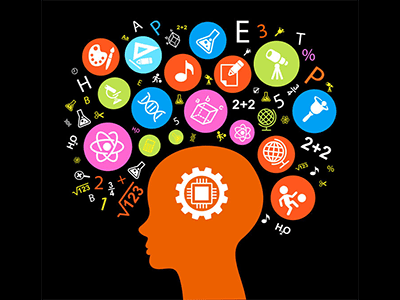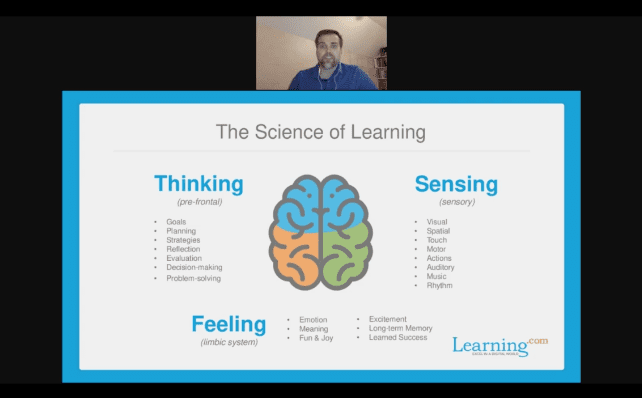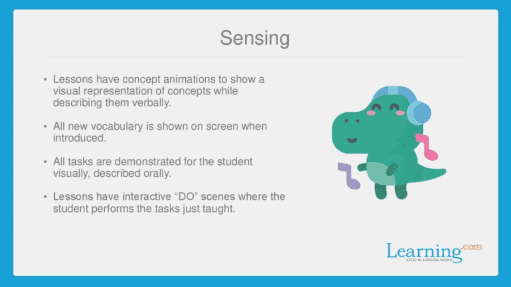Improve the Effectiveness of Digital Instruction
The principles of learning have been around for centuries while only in the last 20 to 30 years has the science of learning been studied. According to Paul W. Ownby, Senior Product Manager at Learning.com, during a recent edWebinar, the science of learning focuses on how we learn and how we can maximize the retention and storage of information in our brains. By engaging all three areas of the brain, thinking (pre-frontal), sensing (sensory), and feeling (limbic system), thinking, creativity and identity skills are activated and maximum learning occurs. Leveraging the science of learning, classroom educators can design content activities that are efficient, engaging, model persistence, and reinforce student identity.
Thinking
The thinking, or decision-making and problem-solving area of the brain, is where goals are established and planned, strategies are devised to reach those goals and success is determined through reflection and evaluation. For students to make connections to their learning, digital instruction should include activities that engage this area of the brain. These thinking engagement activities need to communicate the “why” or the purpose of learning the skill, create opportunities for collaboration and provide interactive activities that guide students through a reflection process.
Sensing
The sensing portion of the brain stimulates sensory skills such as visual, spatial, touch, motor actions and auditory. When students’ senses are activated, they become engaged in the learning process because they find ways to personalize their connection to the concept. Ownby suggests that digital instruction includes activities, tasks, and lessons that show visual and verbal representations of concepts such as animation, music and descriptions. Experiences that have interactive “do” scenes where the student performs the tasks just taught will provide them with opportunities to be active, collaborative, and reflective participants in the lesson.
Feeling
The last area of the brain, feeling, is where emotion is believed to be the primary function in information retention and brain stimulation. When classroom teachers introduce a concept, it is critical that students associate it in the context of positive emotions such as fun and excitement and that the idea or lesson connects to students’ past experiences of learning success. The design of this focused science of learning principle ensures that students feel successful regardless of their understanding of the concept. By accessing the feeling or emotional part of the brain, students have a strong desire to want to revisit and dive deeper into the topic.
Ownby stresses two critical components in the triad of the science of learning—identity reinforcement and recall practice. When students connect with their interests, cultures, or past experiences, they create personal connections to their education. This personalized connection to their learning creates experiences of success for students, and they see themselves as capable in the subject area presented in their lessons. Reinforcement strategies for ensuring that all students identify with classroom instruction include developing lessons and activities around subject areas with a broad range of ideas and interest areas. When students with a variety of interests and backgrounds are active participants in a lesson, the retention of information increases dramatically. A much newer component in the science of learning is recall practice, which creates pathways in the brain so that it is easier for students to recall the lesson in the future. These pathways connect concepts learned in other areas of the brain to the idea taught at the moment. Recall practice includes the cross-pollination of subjects and topics and regular practice of skills such as keyboard instruction that develop brain and muscle memory for recall.
This edWeb broadcast was sponsored by Learning.com.
This article was modified and published by EdScoop.
About the Presenter
Paul Ownby, Senior Product Manager for Learning.com, provides product direction for Learning.com’s digital literacy, computer science, and coding curricular products. Paul has worked in product management and content development for over 20 years with a particular focus on technology and education. As part of the initial product and development team for Learning.com’s EasyTech curriculum, Paul worked closely with co-founder Barclay Burns to establish content design guidelines for Learning.com’s interactive lessons that leveraged principles found in the Science of Learning to maximize learning in online lessons. He is passionate about digital and technical learning, and leveraging what we know about how we learn to make learning and teaching efforts more efficient.
About the Host
Jeff Meyer, Director of Education for Learning.com, provides thought leadership, professional development, and consulting with educators, parents, and students regarding the importance of digital literacy education and how Learning.com helps students excel in a digital world. Jeff has worked in public education since 1982 as a high school English language arts teacher and physical education coach. After receiving an M.Ed in curriculum and instruction and instructional technology, Jeff worked as Director of Professional Development and Instructional Technology in the Eanes Independent School District in Austin, Texas and then was named Director of Instructional Technology for Austin Independent School District in 2000. Jeff joined Learning.com in 2005 and has worked in a variety of roles, including professional development, customer services, and product marketing. He is passionate about the need to transform education using data-based, student-centered approaches and digital resources to prepare students for the future.
Join the Community
Success in a Digital World is a free professional learning community on edWeb.net that will help you prepare your students with the skills they need to excel in our digital world.
Learning.com helps students, teachers, and schools excel in a digital world. We provide solutions to support educators as they build students’ digital literacy skills and transition to digital content. We work with 1 in 6 districts across the US and serve 5.6 million students across more than 20 countries.





Comments are closed.